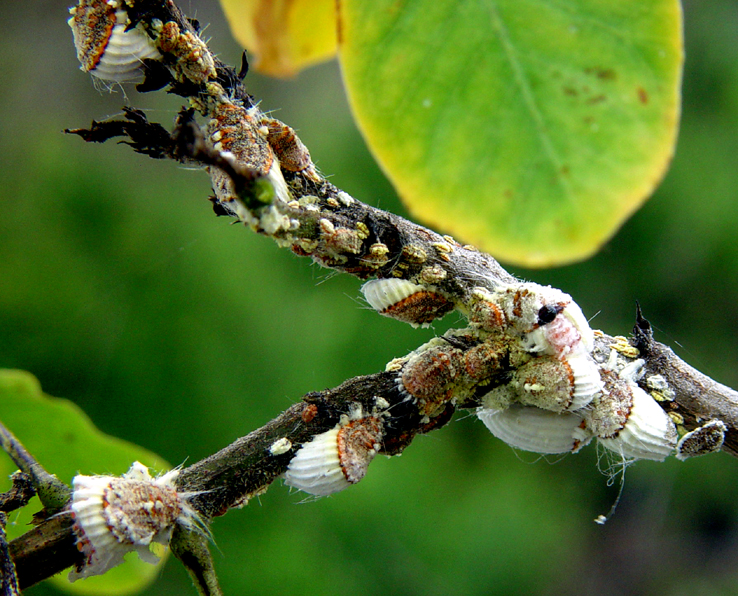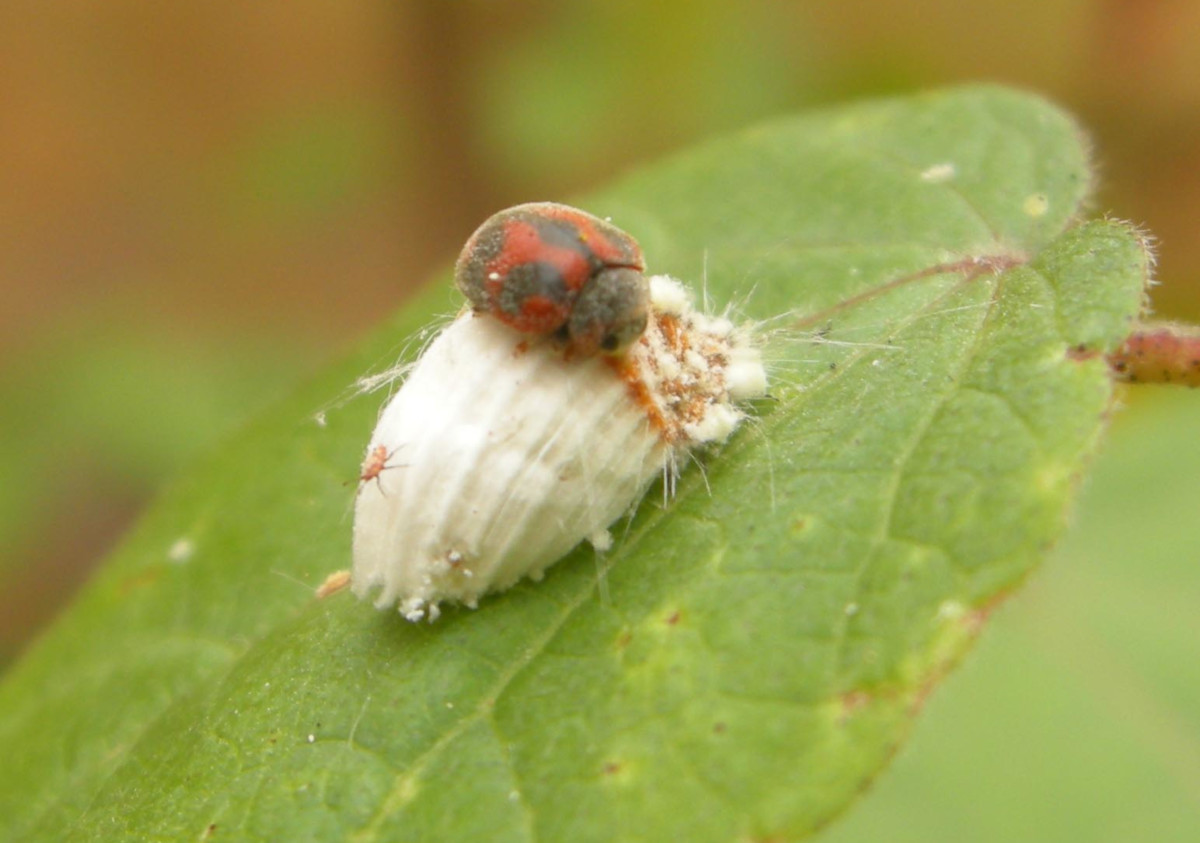Galapagos Species Database
The Galapagos Species Database shares the information about the species from our Natural History Collections.
Icerya purchasi
Escama algonodosa, Cottony cushion scale




The Cottony Cushion Scale is a self-fertile hermaphrodite (has both male and female organs). The brownish adult (3 mm long) produces a white ridged cottony egg sack that is attached to her rear (6 mm long). 600-800 eggs are extruded into the sack and stay there during development to emerge as small crawlers that disperse. The crawler moults 3 times before becoming an adult. The final instar and adult stage are sedentary and feed on sap. They form large colonies along the branches and stems of plants and are often protected from predators by ants which, along with a black sooty mould, feed off a sugary honey waste produced by the scale.
Domain
Eukaryota
Kingdom
Animalia
Phylum
Arthropoda
Class
Insecta
Order
Hemiptera
Suborder
Sternorrhyncha
Superfamily
Coccoidea
Family
Margarodidae
Genus
Icerya
Species
purchasi
Taxon category: Accepted
Taxon origin: Introduced - established
Preference for an altitude zone in Galapagos: Coastal zone - high altitude dry zone
Substrate or host preferences: 80 plant species
Feeding preferences: Highly polyphagous, feeds on a wide variety of plant species.
Trophic role: Parasite
Reproductive biology: Cottony cushion scales have four ('female') or five (male) stages. As with all scale insects, the females do not produce wings and look similar to the immature stages. The males possess a single pair of dusky wings. However the 'females' are actually hermaphrodites with fertilization occurring between the eggs and the sperm of the same individual. Sexually functional males are occasionally produced from unfertilized eggs. Adult females produce 500-2000 bright-red, oblong eggs over a period of 2-3 months. The number of eggs produced depends on the size of the body, condition of the host and climatic conditions. After leaving the egg sac, the crawlers settle along the midribs and veins of the leaves. The next two instars migrate to the larger twigs and branches and eventually moult into the adult 'female'. There are 2-4 generations each year.
Distribution origin: Australia
Dispersal propagule: Los "crawlers", como otras escamas pueden ser distribuídas por el viento, insectos voladores y pájaros.
Natural enemies: Rodolia cardinalis
Associated species in Galapagos: No
Mode of introduction: Accidental
Introduction Pathway: Contaminant
Subpathway: Contaminant on plants (inc. seeds and plant associated material)
Introduced status: Naturalized
Invasive status: Invasive
Invasion risk score: Extreme risk
Impact in Galapagos: In Galapagos the species has been recorded to feed on 80 plant species, of which 31 are endemic, causing a decline in their populations, and affecting the food source of endemic herbivores. Its impact on mangroves was sufficiently intense to cause concern about losing this unique habitat.
Impact elsewhere: Weakens plants by sucking sap, which impacts agricultural crops and threatened species.
Control History in Galapagos: A multi-agency review concluded that biological control was the only feasible option to manage this species. The vedalia beetle (Rodolia cardinalis) was chosen because of its proven success and high specificity to Icerya purchasi. Extensive trials were carried out in quarantine in 1999 to ensure its specificity, and to quantify the impact of the scale on native plants. Following approval by the National Park Service R. cardinalis was released onto 11 different islands between 2002-2005. Monitoring was carried out soon after release, and again from 2009 -2011. Results indicate the the beetle is effectively controlling the scale and low levels, and also maintaining its own population. Five yearly monitoring programs will continue to be necessary to ensure that the species is being effective.
Control methods elsewhere: Simple control methods include spraying with detergent mixture or using insecticides. Preventing ants from protecting the colonies allows natural predators to remove the scale. Biological control is also commonly used throughout the world.
Year of first record: 1982
Map of specimen collection localities or observation records for this species in our collections database.
Distribution: Widely distributed across the archipelago, including the islands of Baltra, Floreana, Isabela, San Cristóbal, Santa Cruz, Seymour Norte, Santiago, Fernandina, Santa Fé, Marchena, Pinta, Pinzon, Rabida, Genovesa, and Champion. Originally from Australia. First recorded in Galapagos on San Cristobal in 1982.
- Peck, S.B. (2001) Smaller Orders of Insects of the Galápagos Islands, Ecuador: Evolution, Ecology, and Diversity. NRC Research Press, Ottawa, Ontario, Canada, 278 pp.
- Lincango, M.P. Hodgson, C. & Causton, C. (2008) Lista anotada de los insectos escama (Hemiptera: Coccoidea) de las islas Galápagos, Ecuador. Charles Darwin Research Station, unpublished, 17 pp.
- Peck, S.B. Heraty, J., Landry, B. & Sinclair, B.J. (1998) Introduced insect fauna of an oceanic archipelago: The Galápagos Islands, Ecuador. Am. Entomol. 44: 218-237.
- Lincango, P. Hodgson, C., Causton, C. & Miller, D. (2010) An updated checklist of scale insects (Hemiptera: Coccoidea) of the Galapagos Islands, Ecuador. Galapagos Research, 67: 3-7.
- Roque-Albelo, L. (2003) Population Decline of Galapagos endemic Lepidoptera on Volcán Alcedo (Isabela Island, Galapagos Islands, Ecuador): An effect of the introduction of the cottony cushion scale? Bulletin de L'Institut Royal des Sciences Naturelles de Belgique 73: 177-180.
- Causton, C.E. Sevilla, C. (2008) Latest Records of Introduced Invertebrates in Galapagos and Measures to control them. Galapagos Report 2006-2007, CDF, GNP and INGALA, Puerto Ayora, Galapagos, Ecuador, p. 142-145.
- Causton, C.E. Lincango, M.P. & Poulsom, T.G.A. (2004) Feeding Range Studies of Rodolia cardinalis (Mulsant), a Candidate Biological Control Agent of Icerya purchasi Maskell in the Galápagos Islands. Biological Control 29: 315-325.
- Causton, C.E. (2001) Dossier on Rodolia cardinalis Mulsant (Coccinellidae: Cocinellinae), a potential biological control agent for the cottony cushion scale, Icerya purchasi Maskell (Margarodidae). Charles Darwin Foundation, Galàpagos.
- Liu, H. Tye, A., Jaramillo, P., Simbaña, W., Madriz, P., An, S., Wang, Z., Xu, X., Wang, F. G., Xu, H., Song, X. Q., Trusty, J., Maunder, M., Lewis, C. &Francisco-Ortega, J. (2012) Science at Fairchild: Conservation and biodiversity on Pacific Ocean Islands. Tropical Garden 65(1): 28-31.


Feeding type: Phloemivorous